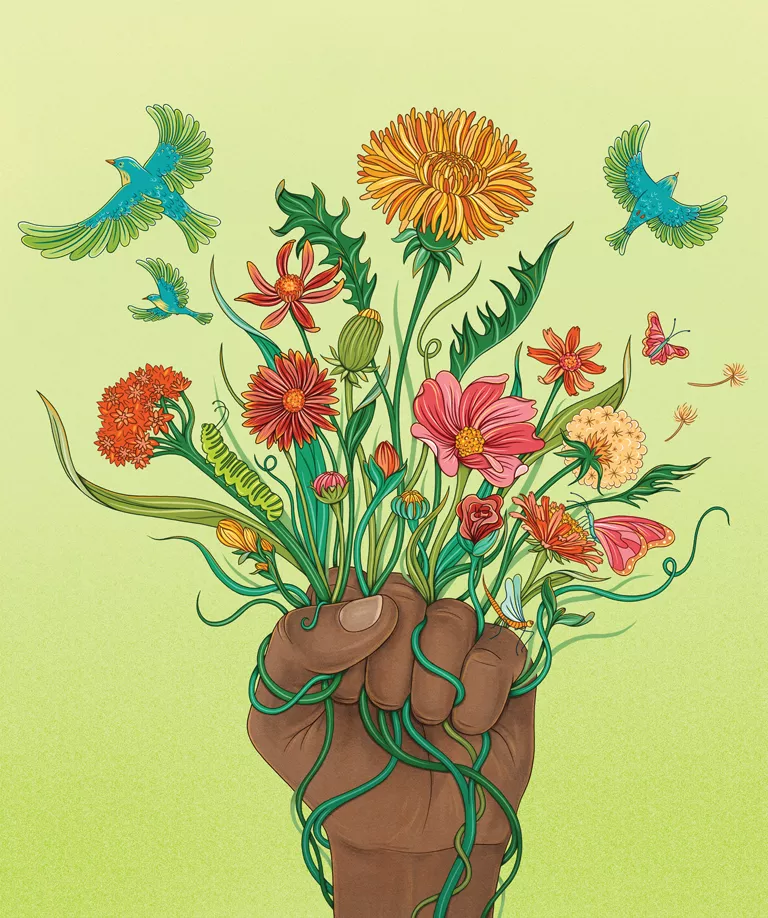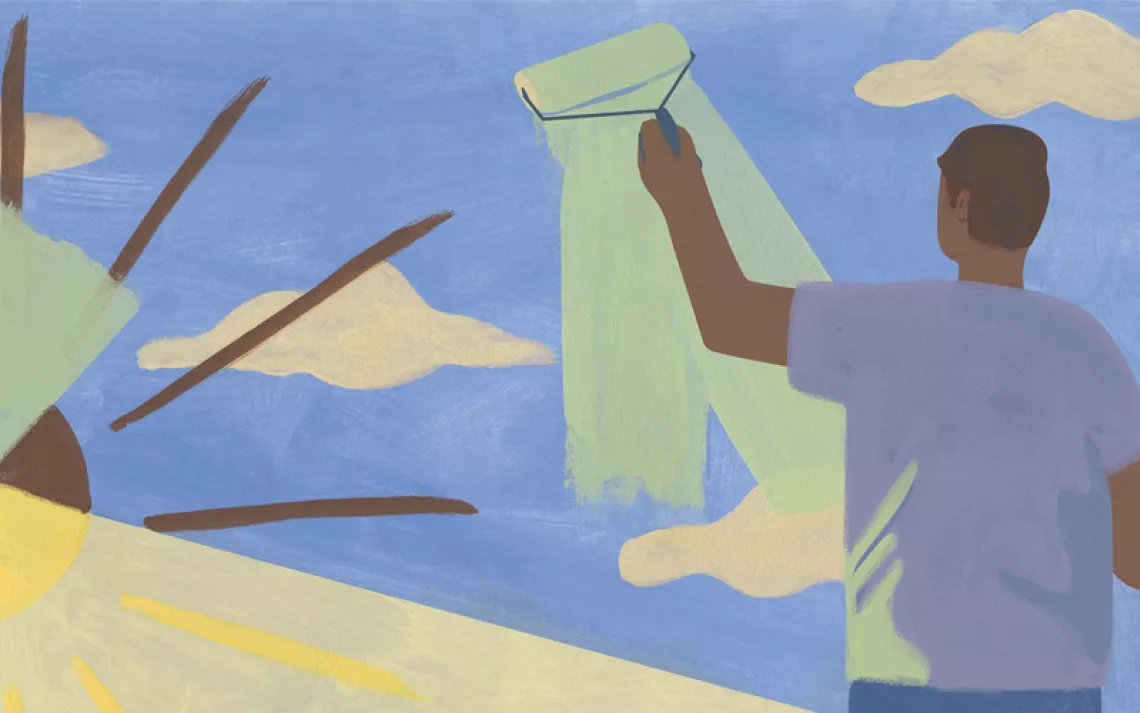How Writers of Color Are Changing What Nature Writing Looks Like
A new generation of writers reboot a genre

Illustration By Gaby D'Alessandro
In the winter of 2021, still very much in the midst of the pandemic, I started reading The Collected Poems of Audre Lorde. Lorde was a queer Black writer who had become a literary hero of mine after I read her essays on feminism, sexuality, and racial justice. As I began exploring her poetry, I was immediately struck by how often she used nature to process the political realities of her life. "Love Poem" uses erotic descriptions of landscapes to capture the intimacy of her queer relationships. "The Brown Menace, or Poem to the Survival of Roaches" celebrates Black resilience, while "Second Spring" meditates on the dissonance of seasons changing as we are still mourning the past. Lorde writes:
We have no passions left to love the spring
Who had suffered autumn as we did, alone
Walking through dominions of a browning laughter
Carrying our loneliness our loving and our grief.
When I read "Second Spring"—with the 2020 global uprising against police violence still relatively fresh and just weeks after the attack on the US Capitol—the poem captured the spiritual exhaustion of the moment, how the earth sometimes moves faster than our grief does. As a queer Latina writer who had spent years writing about nature, finding Lorde's poetry felt like a relief. Finally, I had found a writer who wrote about nature in a way that was inextricable from every system of power we lived in. Before, when I had tried to read anything by someone labeled as a "nature writer," the blatant omission of the forces that so deeply affected my outdoor experiences—white supremacy, colonialism, patriarchy—made me feel distant from their work.
New nature writers of color provoke a radically important question: Who should have the power to narrate what the earth wants?
When Lorde published her first book of poems, her publisher, Dudley Randall, was quick to clarify, "Audre Lorde is not a nature poet." I could relate to this impulse to separate her from the genre. Nature writing seemed to be unconcerned with the realities of oppression; it was writing that waxed poetic about the solace of the American landscape without any consideration of the historical context of that land, unbothered by the many communities displaced from it.
Now, however, what counts as nature writing—and who identifies as a nature writer—is beginning to change. In recent years, as the environmental movement has started to grapple with its historical connections to racism and xenophobia, a new generation of poets, essayists, memoirists, and novelists of color is taking up space in a genre that historically has excluded our perspectives. They include Ross Gay, Natalie Diaz, Kim TallBear, Camille Dungy, and Aimee Nezhukumatathil, among many others. They have raised their voices in anthologies like The Language of Trees, edited by Katie Holten, and A Darker Wilderness, edited by Erin Sharkey. Books like Sabrina Imbler's How Far the Light Reaches embody a nature writing that centers the most marginalized and names the violent histories inherent in shaping our relationship to nature. More important, they remind us that oppressed people have always partnered with nature when seeking our liberation.
In his essay "A Family Vacation" in A Darker Wilderness, Glynn Pogue writes about the first seaside enclaves and mountain towns that allowed Black people to own land, and the first Black-owned bed-and-breakfasts that thrived there. In "Concentric Memory," Naima Penniman writes about how forests, swamps, and brushlands gave sanctuary to maroon communities of escaped slaves in Haiti and Latin America. Carl Phillips's piece in The Language of Trees describes how forests became his refuge for queer intimacy, a space that provided "a sense of permission at least, to what can feel like—what we've been made to feel is transgression; if only temporarily, the trees erase the shame that drove us to seek hiddenness in the first place."
In these pages, nature is inherently political. It is an active ally in the fight against oppression, a place where marginalized people can experience brief moments of life outside systemic trauma. And it's a place where we find the examples we need to give us hope for our survival. In How Far the Light Reaches, Imbler compares the "supernaturally hardy" resilience of feral goldfish that took over an entire river ecosystem in Southwest Australia—all descendants of a handful of pets someone dumped two decades ago—to the resilience they and their queer community needed to survive and "how each of our becomings felt like an unthinkable triumph." Imbler writes, "A dumped goldfish has no model for what a different and better life might look like, but it finds it anyway. I want to know what it feels like to be unthinkable too, to invent a future that no one expected of you."
In her book Trace: Memory, History, Race, and the American Landscape, Lauret Savoy writes about the Western Apache (Ndee) word ni, meaning both "land" and "mind," which illustrates "the inseparability of place and thought." "In 'ni,' earth and thinking converge," she writes. "What's crucial is to think and act with landscapes, as well as about and upon them."
This insight revealed something I appreciate when reading nature writers of color: They write with landscapes, not only about and upon them. In so many of the environmentalist spaces I have worked in, I've often heard about "saving" the earth—a message that implies a human superiority we don't actually possess. Nature writers of color instead emphasize relating with the earth. They write with an assumption of partnership and solidarity between humans and nature, both working toward a mutual goal of liberation, rather than an uneven relationship in which it's humanity's task to save everything else.
When Audre Lorde's publisher said that she was not a nature writer, he justified his argument by stating that "her focus is not on nature, but on feelings and relationships"—as if those concepts were mutually exclusive. Today's nature writers of color know differently, and Lorde knew it long ago: Writing about nature is writing about feelings and relationships, because our relationship with nature is constantly related to how we learn and think about ourselves.
Since reading Lorde's poetry, I began teaching a workshop called "Reclaiming Nature Writing." When I ask participants what they received from the course, an answer I hear often is "permission." Too many writers still believe their stories about race, sexuality, or ancestry don't count as nature writing. Once they read writers of color who validate their own unique relationship to nature, they allow themselves to write their own stories.
So much of the recent conversation around diversifying both the publishing industry and the environmental movement has focused on giving people of color "a seat at the table." These new nature writers of color tell stories that change the table entirely. They don't simply add a new voice to the discourse; they transform what and who is centered, what core assumptions about nature we first must dispel. In doing so, they provoke a radically important question: Who should have the power to narrate what the earth wants?
In an essay titled "Brutes: Meditations on the Myth of the Voiceless," best-selling author Amitav Ghosh argues against the idea of nature as a "voiceless" entity needing humans to stand up and defend it. He believes that nature has been telling us stories far before humans ever could. The task of human storytellers is to simply listen and to find ways to "imaginatively reassign agency and voice to nonhumans," Ghosh writes. "This is a task at once aesthetic and political—and because of the magnitude of the crisis that besets the planet, it is now freighted with the most pressing moral urgency."
The more I read nature writing from writers of color, the more it's clear to me that perhaps instead of seeking out new and innovative ideas to address the ecological crisis, we should be returning to ancient stories, the stories Earth has been telling us for centuries. We can confront this crisis not by trying to save the planet but by listening to it. And in doing so, we may discover that Earth's story—of severed connection and exploitation—is much the same as our own.
 The Magazine of The Sierra Club
The Magazine of The Sierra Club



